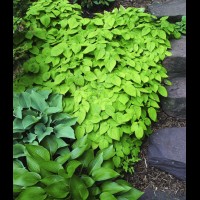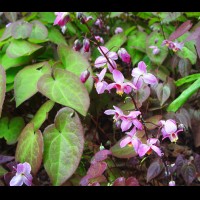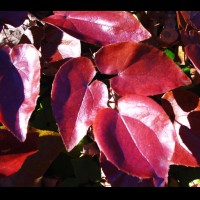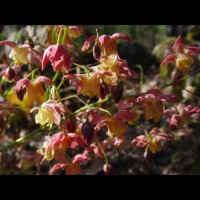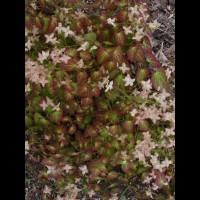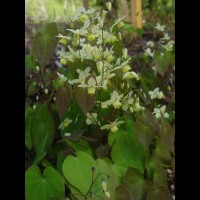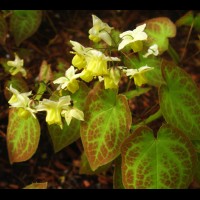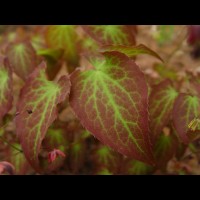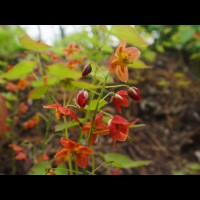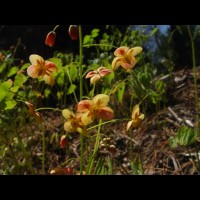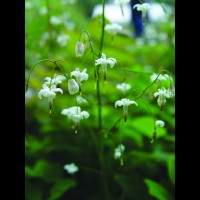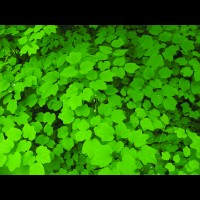Epimedium alpinum
Epimedium alpinum (Cc. 920002)
This drought tolerant spreading species from southern Europe sports very small flowers held below and among medium-sized leaflets. Inner-sepals are red behind creamy-yellow petals/spurs. 12" tall. The leaflets flaunt a complementary thin, mascara-like red edge while the plant is in bloom. Spreads 8-12" a year, forming an open groundcover. Semi-evergreen.
Epimedium alpinum 'Shrimp Girl'
E. alpinum ‘Shrimp Girl’ (Cc. 930006)
The clone ‘Shrimp Girl’ is shorter in height (6-8”) than E. alpinum with shorter rhizomes; spreading only 4-5” a year. Its dense growth habit and thick foliage make it far superior at crowding out weeds. Tiny blooms appear below the leaves and are not usually noticeable unless the plant is elevated on a hillside. A short, neat, ground-covering Epimedium with a "cool" name. Semi-evergreen.
Epimedium koreanum 'Harold Epstein'
Epimedium koreanum ‘Harold Epstein’ (Cc. 930004)
A very cold hardy clone with huge flowers for an Epimedium— gorgeous and butter yellow. Named in honor of Harold Epstein by plantsman Jerry Flintoff, its enormous leaflets can reach over 6” long and 4-1/2" wide. Spreads 6-12" a year. It usually takes 2-3 years to establish itself and become most impressive. The flowers emerge before the leaflets unfurl in early spring. E. koreanum is notorious for just putting up one set of leaves per node each season. If the leaf suffers damage, the rhizome will remain dormant until the following year. ‘Harold’ is a great bold-textured vigorous ground cover for large areas where it can spread unimpeded. It is especially useful in combination with early spring bulbs for sequential bloom. After bloom the expanding leaves serve as camouflage for the dying bulb foliage. 15" tall.
Epimedium macrosepalum
E. macrosepalum (Several clones/Cc. numbers)
An evergreen and drought-tolerant species from the S.E. coastal region of Russia. The flower of this species makes up for its paucity of flowers with their size. The flowers have enormous (for an Epimedium) inner sepals that are a heavenly shade of lavender-pink. Unlike most inner sepals that follow the curve of the spurs, these petaloid structures reflex back like huge rounded wings, arching above the down curving spurs, like an insect taking flight. Both the cup and the tips of the spurs fade to white. Ground hugging foliage 4-8” high is composed of small to medium-sized rounded, heart-shaped leaflets that turn deep maroon over winter. Its low, running habit makes this species a good groundcover. Vigorously spreads by thin 4-12” rhizomes.
Epimedium macrosepalum 'Sweet Rachel'
Epimedium macrosepalum ‘Sweet Rachel’ (Cc. 040102)
***2010 Cobblewood Introduction***
This beautiful, smaller foliaged form has very shiny, bright burgundy leaves in winter if grown in some sun. The ground-hugging, heart-shaped leaves have the texture of the finest leather. Same beautiful, large rose pink flowers as the species and a reliable bloomer, but with very few flowers. Spreads by thin rhizomes which grow from 4-12”a year. From a plant collecting trip Darrell sponsored in cooperation with the U.S. National Arboretum. Drought-tolerant. Evergreen.
Epimedium pauciflorum
E. pauciflorum (Cc. 000480)
Native to the parched regions of western Sichuan Province in China, this species is drought-tolerant. The attractive, small, rounded, spiny-edged semi-evergreen leaflets sometimes exhibit splashes of reddish-brown in spring. Produces 2 to 4 medium-sized, flowers of the palest lavender-pink on sporadic flower stems, hence the species name pauci=few florum=flowers. Spreads by thin 8 to 12" rhizomes. Best used as a very low (4-6") groundcover.
Epimedium perralderianum
E. perralderianum (Cc. 980085)
Native to the moist remnants of oak and cedar forest in northeast Algeria, this drought tolerant species forms a handsome evergreen ground cover. Smaller than E. pinnatum ssp. colchicum, it differs in that its heart-shaped, veined leaflets are in sets of three, with spiny edges that give textural interest. Flowers are much the same-- small, lemon-yellow, and rounded with diminutive mahogany spurs that bend upwards. Leaflets are patterned with red/bronze in spring and fall. Spreading rhizomes grow 2-4". First foliage flush to 4", second to 8" high. This clone is courtesy of the late David Barker, who held one of the national UK collections of Epimediums.
Epimedium pinnatum ssp. colchicum
Epimedium pinnatum ssp. colchicum (Sev. clones/Cc. numbers)
Native to the mountainous areas of Georgia along the eastern coast of the Black Sea, this Epimedium is very drought tolerant. A workhorse groundcover for dry areas. Clusters of small, bright yellow flowers are produced on leafless stems above newly emerging leaves. Showy bright yellow inner-sepals back small petals that form a yellow cup. Short reddish spurs are held straight out against the inner-sepals. Spreads 6-8” a year creating a dense growth of large, rounded, shiny, deep evergreen leaflets on stems 8-10”.
Epimedium pinnatum ssp colchicum L321
Epimedium pinnatum ssp. colchicum L321 (Cc. 950222)
This Roy Lancaster collection was obtained from Robin White of Blackthorn Nursery. The dark evergreen leaflets are smaller and narrower than those of the other clones we grow, with a decorative wavy edge, making it a much more open plant, but one with a great deal of textural character. A favorite of mine. Otherwise, it is similar to the other clones. Spreads by 4-6" rhizomes. Drought tolerant.
Epimedium pinnatum ssp. colchicum 'Thunderbolt'
Epimedium pinnatum ssp. colchicum ‘Thunderbolt’ (Cc. 890003)
***2000 Cobblewood Introduction***
Collected in the former USSR Province of Georgia in 1973 by Skip March of the U.S. National Arboretum. We named this clone in cooperation with the Arboretum. Cool autumn temps turn the medium-sized, semi-glossy, evergreen leaflets either dark black/purple or a rich red mahogany, depending on the light exposure. An attractive “thunderbolt” pattern of green main veins overlays the fall color. Flowers have showy bright yellow inner-sepals. 10”. Spreads by rhizomes that grow 6-8” a year making this a great groundcover. Particularly drought tolerant.
Epimedium pinnatum ssp. pinnatum
E. pinnatum ssp. pinnatum (Cc. 980084)
This eastern subspecies of E. pinnatum is uncommon in cultivation. Native to the Caspian forests of northern Iran, the late David Barker shared this with us when we visited his garden in Chelmsford, Essex, UK in 1998. Sprays of small, bright lemon-yellow flowers with tiny brown spurs erupt in early spring to 7” beyond the newly emerging foliage. While the flowers are different from ssp. colchicum in having spurs that are half the length, gardeners will notice the difference in plant habit. Generally taller with 9 medium-sized evergreen leaflets per leaf vs. 3-5. Flowers 3/4” in diameter. Leaflets are a clear spring green with a slight rose flush. Spreads by 8” rhizomes. Light red fall color. The earliest of the E. pinnatums to leaf out in spring.
Epimedium platypetalum
Epimedium platypetalum (Several clones/Cc. numbers)
Native to China, 12 to 15” stems carry 10 to 20 dainty yellow bells suspended like tiny shuttlecocks, backed by tiny, white or reddish inner-sepals. The delicate blooms are held aloft on upright stems rising above small, rounded leaflets. Spreads by 8-12” long rhizomes, forming a low groundcover. Small, rounded, and slightly flecked new spring leaflets have few spines. While evergreen, the leaves flatten in the winter and are not very ornamental during that season. A particularly drought tolerant species.
Epimedium pubigerum Cc. 920029
E. pubigerum (Cc. 920029)
Attractive small, round, heart-shaped leaflets with a matte surface, a wavy edge and a bronze overlay in spring, form on stems 8 to 10" tall. Full sprays of very small, pink-flushed, creamy-white flowers hover well above the leaves at 16-20". Early bloomer that initially stays in a clump, but with age, throws short 1-3" rhizomes, with occasional longer ones. Semi-evergreen.
Epimedium pubigerum Cc. 950215
Epimedium pubigerum (Cc. 950215)
This clone bears creamy-white flowers-- almost like tiny molars, creating a baby's breath effect-- held high above especially rounded, glossy dark green leaflets. Foliage 8-10" tall with flowers stems held at 16-20" tall. Drought tolerant. Semi-evergreen.
Epimedium pubigerum Cc. 000996
E. pubigerum (Cc. 000996)
A unique running version of this normally clump-forming and especially drought tolerant species. Handsome corrugate bright green medium-sized leaflets form an attractive, open ground cover. Abundant flower sprays reminiscent of baby's breath cover the foliage extending to 16". Each small flower has cupped white sepals that sport a smear of rose color along their lengthwise edge. A slow spreader with 2-4" rhizomes. Foliage reaches 8". Semi-evergreen.
Epimedium sempervirens 'Candy Hearts'
Epimedium sempervirens ‘Candy Hearts’ (Cc. 920038)
***2001 Cobblewood Introduction***
Exquisite spring foliage emerges an opalescent rosy-pink tone that slowly recedes over a month’s time to a rose border, before turning solid green. The showy large silvery lavender-pink flowers have wide inner-sepals and look like iridescent pearls against the colorful spring foliage. 9” tall. Semi-evergreen with medium-sized leaflets.
Epimedium 'Flame Thrower'
Epimedium ‘Flame Thrower’ (Cc 990619)
***2009 Cobblewood Introduction***
Cheerful cherry red and creamy yellow flowers dance above the foliage of this hybrid from Darrell Probst. The inner sepals have decorative undulations to their shape, resembling flames licking upwards from the top of the flower. This cross between deciduous and evergreen parent plants gives this hybrid both vigorous growth and deep green, spiny leaflets of good substance. Drought-tolerant.
Epimedium 'Lilac Cascade'
Epimedium ‘Lilac Cascade’ (Cc. 950236)
***2001 Cobblewood Introduction***
In spring the new foliage emerges in beautiful shades of rose and pink. By bloom time, the leaflets turn almost solid green with a purplish-red border, forming a perfect mound of cascading foliage. Just above the leaves are clusters of rich violet-lavender flowers. Later, a second flush of vibrant hot raspberry-pink foliage emerges and remains colorful for several weeks. 6 to 8” tall in bloom with the second flush to 12-14”. From Darrell Probst's cross between E. sempervirens ‘Candy Hearts’ and E. grandiflorum ‘Yubae’. The foliage is like the former— semi-evergreen, medium-sized round hearts. Drought-tolerant.
Epimedium 'Pretty In Pink'
Epimedium ‘Pretty in Pink’ (Cc. 130001)
This 2012 Plant Delights Nursery introduction by Tony Avent is a vigorous E. grandiflorum hybrid with exceptional foliage. Small clusters of large, showy flowers with pink spurs and a raspberry cup are held just above the leaves during the mid-late Epimedium bloom season.
The new spring growth is patterned with subdued maroon flecks, eventually hardening off as handsome, glossy, medium-sized green leaflets, followed by a flush of blush pink second growth foliage. Tony describes the leaflets as "tardily deciduous"-- what I call "semi-evergreen". One of the best for thick, lustrous summer foliage. To 12".
E x cantabrigiense "Red Form"
E. ×cantabrigiense “Red Form” (Cc. 950018)
A tough, slightly-spreading natural hybrid of E. alpinum, which the deeply veined leaves most closely resemble, and E. pubigerum, which the floral sprays most resemble. One of many plants for which we are grateful to Jerry Flintoff, as Darrell has not found it elsewhere in the U.S. This clone was very common in many of the British gardens we visited in April 1998. The sepals are dark red rather than the pale salmon of the clone commonly cultivated in the U.S. Numeroua, small flowers bloom well above the leaves on loosely branched 18” stems. More vigorous than the U.S. form, with larger, medium-sized leaflets. Semi-evergreen.
Epimedium x perralchicum
Epimedium x perralchicum
(Several clones/Cc. numbers)
Long confused in the U.S. as its parent, E. perralderianum, (the other being E. pinnatum ssp. colchicum). The floral differences are minor, but the hybrid is more vigorous and hardier, to USDA Zone 4. Large, evergreen leaflets have slightly wavy margins. Like its parents, the leafless stems have small rich yellow flowers reminiscent of Verbascum. Spreads by 4-6” long rhizomes. Leaves form a thick mass 8-10” high. An excellent drought-tolerant groundcover that remains exceptionally evergreen through our harsh New England winters.
E. x perralchicum 'Frohnleiten'
E. x perralchicum ‘Fröhnleiten’ (Cc. 890005)
A drought-tolerant ground cover Epimedium prized for its colorful spring foliage, a gorgeous combination of reddish-bronze over the leaflet with an intricate pattern of green veins. Small, bright yellow flowers. Spreads 4-6” a year with medium/large evergreen leaflets that remain exceptionally evergreen through our harsh New England winters. 12” tall. Blends superbly with yellow-flowered late blooming Narcissus. One of the more common varieties available in the American market, and for good reason.
Epimedium x perralchicum 'Wisley'
Epimedium x perralchicum ‘Wisley’ (Cc. 960041)
A spontaneous hybrid discovered at the Royal Horticultural Society Garden at Wisley, England. Small, bright canary-yellow flowers are produced just above the newly emerging spring foliage to 10”. Medium to large leaflets are dark green with lighter veins and a delicate ruffled edge. The surface of each leaflet is shiny and "puffed" up between the veins, giving it a lustrous, faceted appearance that catches the light. Spreads by 4-6" rhizomes. A great drought-tolerant ground cover with exceptional evergreen leaflets that hold up through most of our harsh New England winters.
Epimedium x rubrum 'Sweetheart'
Epimedium x rubrum ‘Sweetheart’ (Cc. 930007)
***1997 Cobblewood Introduction***
This cultivar easily rivals Hosta as a bold textural garden accent. The first of Darrell Probst's Epimedium introductions, resulting from a 1991 cross he made between E. sempervirens ‘Candy Hearts’ and E. alpinum. Flowers with dark rose-red sepals bloom above and below the leaves. Leaflets are much larger, darker green and more rounded than is typical. Large, shiny new leaflets bear a thin red rim in spring. Semi-evergreen. 16" tall. Foliage is far superior to E. x rubrum, and the plant is much more drought-tolerant. Spreads by 2-4" rhizomes.
Epimedium x versicolor 'Cherry Tart'
Epimedium x versicolor ‘Cherry Tart’ (Cc. 970064)
***1999 Cobblewood Introduction***
A spontaneous seedling originating in the garden of Judy Springer, formerly of Great Falls, VA. Erect stems sport numerous, outfacing flowers. Large, medium-pink inner sepals back flaming, cherry-red spurs with a bright, lemon-rimmed cup. Spreads slowly by 2-4” long rhizomes. Medium-sized leaflets are handsomely flushed with reddish-purple in spring with a mustard tone that changes to a dark burgundy blush in the fall. 12-15”. Blooms early and is drought-tolerant. Semi-evergreen.
Epimedium x versicolor 'Cupreum'
Epimedium x versicolor ‘Cupreum’ (Cc. 950143)
Thanks to Carla Lankow of Renton, WA for the original stock of this captivating plant. With the same parents as ‘Versicolor’, it is similar, but has a slightly deeper flower color and more intensely red spring foliage with green venation. Usually with more numerous, slightly smaller leaflets per leaf, each more angular and less rounded. Foliage to 9” and flowers to 12”. Rhizomes grow 4-5” inches/year. Semi-evergreen with deep orange to maroon fall color. An early bloomer, it is also very drought-tolerant.
Epimedium x versicolor 'Neosulphureum'
E. x versicolor ‘Neosulphureum’ (Cc. 920044)
Undeservedly rare in cultivation, this counterpart to the more common ‘Sulphureum’ is shorter and semi-spreading with 2-4” rhizomes that form a tight groundcover. Pale yellow flowers are held on 12” erect, airy sprays. Flower spurs half as long as the inner-sepals. Spring leaflets are nicely bronzed on stems 6-8” and form a darker background against which to view the soft yellow flowers. Early bloomer and drought-tolerant. Semi-evergreen.
Epimedium x versicolor 'Strawberry Blush'
E. x versicolor ‘Strawberry Blush’ (Cc. 990615)
***2004 Cobblewood Introduction***
Wide, antique pink sepals brushed with rose streaks back a cheerful lemon-yellow cup, which deepens to rose purple short, curved spurs. The soft pastel flowers blend beautifully with the pinkish maroon mottled new spring leaflets. Darkest at the edges, the color fades to green at the center of small/medium-sized leaflets, before turning entirely green. Handsome, medium green, glossy summer/fall foliage. Particularly drought tolerant. Semi-evergreen. Flowers/foliage to 10”. Spreading rhizomes grow 2-4" per year. Drought-tolerant.
Epimedium xversicolor 'Sulphureum'
Epimedium xversicolor ‘Sulphureum’ (Cc. 840002)
(Synonym: E. pallidum)
Superb in mass plantings, it spreads 4-5” a year, forming a thick groundcover of leaves that holds its own against weeds. Bears long sprays of pale yellow flowers with spurs nearly equal in length to the inner-sepals are produced above leaflets flushed red in spring. 10" tall in bloom. Semi-evergreen leaves. Drought-tolerant.
Epimedium x versicolor 'Versicolor'
E. versicolor x ‘Versicolor’ (Cc. 890006)
(syn. E. x versicolor 'Discolor')
Quite rare in gardens, this has long been one of our favorite clones. Delicate flowers open a deep, rich pink-salmon, and fade over the course of several days. Large panicles of flowers hover above leaflets strongly flushed with red in spring. It spreads 4 to 5" a year forming a gorgeous mass of riotous color in spring. 14" tall. Early bloomer and drought-tolerant. Very similar to E. x versicolor 'Cupreum' in appearance and habit. Semi-evergreen.
Epimedium x warleyense
E. x warleyense (Cc. 890007)
Bright orange flowers make this evergreen sterile hybrid between E. alpinum and E. pinnatum ssp. colchicum unusual. From Miss Willmott’s garden, Warley Place, England. Sprays of small flowers float above rounded, medium-sized, bright green, rounded leaflets. Spreads 5-6" a year with an open growth habit. Foliage to 8”, flowers to 12". Drought-tolerant.
Epimedium x warleyense 'Orangekonigin'
Epimedium x warleyense ‘Orangekönigin’ (Cc. 960140)
A shade or two paler orange than E. x warleyense in bloom, and a top-notch evergreen groundcover, this cultivar was introduced by Ernst Pagels of Germany. The inner-sepals are a soft shade of tangerine traversed by darker orange veins. Shorter rhizomes (2-4") spread to form denser clumps than the straight species, more effectively crowding out weeds. Early bloomer and drought-tolerant. 8-10" tall.
Vancouveria hexandra
Vancouveria hexandra (Several Cc.)
A west coast native, and also a later-blooming relative to Epimedium. This fine-textured, low-growing groundcover sports leaflets reminiscent of “duck’s feet” to 6” high, with flower stems to 15”. Blooms about a month later than do Epimediums, producing numerous small, pendulous white flowers, similar to those of Epimedium, but with six flower parts instead of four. Very drought tolerant and an excellent ground cover for deep shade. Spreads vigorously by thin, 6-10" underground rhizomes. Rumored not to thrive in the deep south.
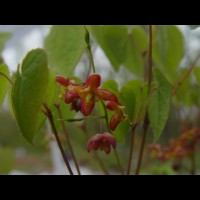
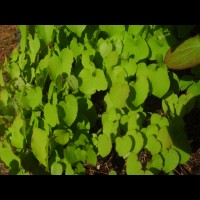
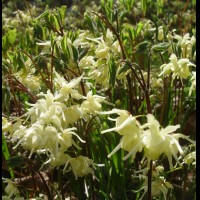
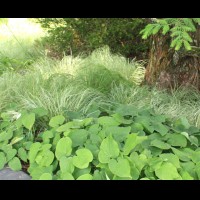
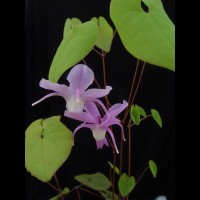
.jpg)

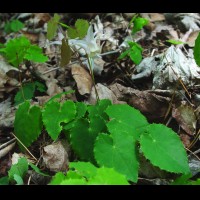
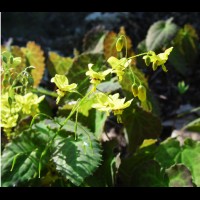
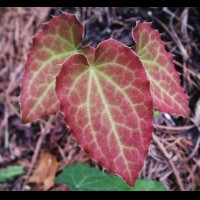
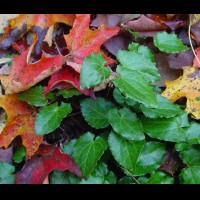
.jpg)
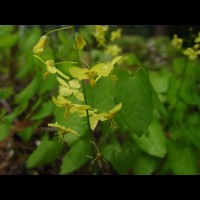
.jpg)
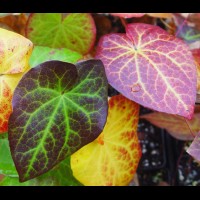
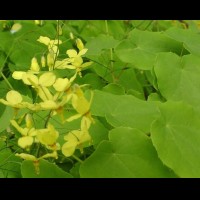
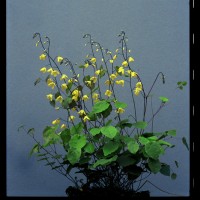
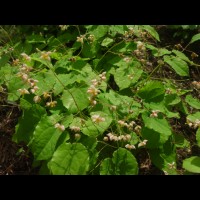

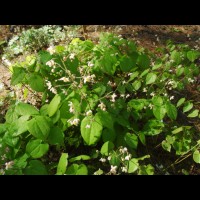
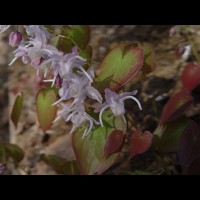
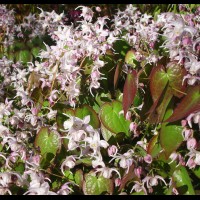
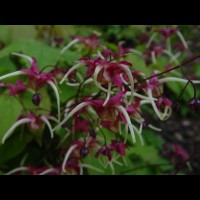
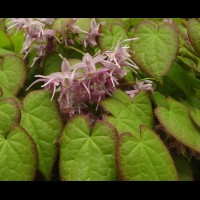
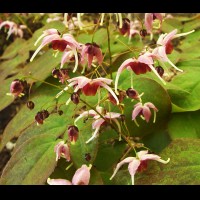
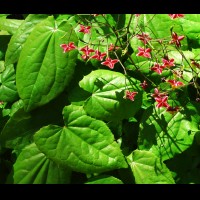
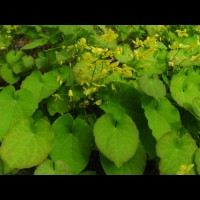
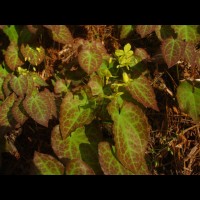
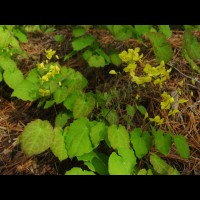
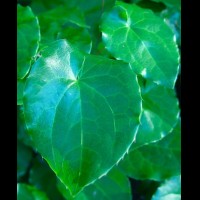
.jpg)
.jpg)
